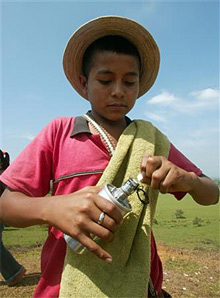 |
 |
 |
 News from Around the Americas | December 2005 News from Around the Americas | December 2005  
Colombian Police Back Off as Indians Grab Land
 Luis Jaime Acosta - Reuters Luis Jaime Acosta - Reuters


| | A Nasa Indian child prepares a gas grenade near Caloto, Colombia, November 24, 2005. The Colombian police, hardened in combat against Marxist rebels, have given up trying to throw a determined group of Nasa Indians off farms they grabbed nearly two months ago in a drive for land rights. (Reuters/Carlos Duran) |
Caloto, Colombia - The Colombian police, hardened in combat against Marxist rebels, have given up trying to throw a determined group of Nasa Indians off farms they grabbed nearly two months ago in a drive for land rights.

Long ignored by government and targeted by both far-right paramilitary outlaws and Marxist rebels, Indians in the southern province of Cauca showed signs of a new militancy five years ago, when they launched a program of passive resistance against combatants in Colombia's 41-year-old guerrilla war.

Emboldened by their partial success in using only ceremonial sticks and stubbornness to drive away armed fighters, the Indians of Cauca have now launched a bid to force the government to hand over land they say it promised them in 1971.

About 2,000 Indians chose the symbolically charged date of October 12 -- Columbus Day, which commemorates the arrival of Christopher Columbus in the Americas and the beginning of European settlement -- to invade 19 farms, with a total area of 10,000 acres, owned by absentee landowners in Cauca.

The Indians say they will stay on the farms, which include the historic Hacienda Japio cattle ranch which once gave shelter to South American independence hero Simon Bolivar, until the government hands over 545,000 acres of land they say is theirs by tradition. They say the land has religious significance, as part of "Mama Kiwe" or "Mother Earth."

At first, the police tried to kick them out, using batons and tear gas. But the Indians fought back with slingshots, stones and sticks, surprising Colombians who are more used to seeing them as passive victims of conflict.

About 100 Indians were injured during a series of skirmishes, mainly by blows to the body, according to the Cauca Regional Indian Council.

Another Indian was shot dead at the Hacienda Japio. Indians blame the police, although the police deny it, and the Attorney General's office has begun a criminal investigation.

After several weeks of regular but indecisive clashes, the police pulled back and have since kept a wary distance as the Colombian government moved in to negotiate with the Indians about their demands.

"What we want is to liberate the Mother Earth, Mama Kiwe, from this cycle of accumulating wealth by squeezing and killing the earth which gives us life," a Nasa leader, Geovanny Yule, told Reuters at the Hacienda Japio.

Following Yule's orders, a group of Indians, armed with clubs and machetes, kept watch from a hilltop in the sprawling Hacienda Japio, in sight of another hill where about 100 police looked back at them.

Ready To Risk Their Lives

Farm workers were still living on another part of the ranch, looking after the livestock.

"The government has been forced to negotiate with us on the occupied ranches. They haven't been able to push us out by force because we feel so strongly about the land that we are willing to risk our lives to get it," said Yule, who wore a straw hat and held a staff symbolic of his position as leader.

There are 85 different Indian groups in Colombia, but together they make up only just over 2 percent of the country's population of 44 million. So, while their political profile is growing, they do not have nearly the clout of emerging Indian movements in countries like Bolivia and Ecuador, which have the power to shake governments.

They have suffered disproportionately from the war, and the United Nations has warned that some Indian groups are in danger of being wiped out. Both illegal paramilitary militias and Marxist rebels operate on their traditional lands, and often kill Indians or conscript them into their ranks.

At least 70 Indians have been murdered so far this year in violence linked to the war, according to Colombia's National Indigenous Organization.

The national government is now talking to the Indians and Interior Minister Sabas Pretelt has proposed giving them land confiscated from cocaine traffickers.

About 5 percent of all of Colombia's farmland is in the hands of drug smugglers, paramilitaries or guerrillas, according to the national auditing office, the Comptroller General.

The Cauca Regional Indian Council says 18 percent of Cauca's 7.5 million acres of farmland is currently occupied by the province's 270,000 Indians and that much of it is poor quality. They say settlers pushed them off the best land long ago and big landowners now have more than they do.

But Cauca Gov. Juan Jose Chaux says there are only 4 million acres of farmland in the region, and that Indians own almost half of it.

He says the Indians have not been as hard done by as they say.

"We can't keep on presenting Cauca as some sort of feudal place where indigenous people are mercilessly persecuted," Chaux said.

"We should see Cauca as a place where the indigenous people weren't exterminated as they were in other parts of Colombia."

Meanwhile, the Indians are still holding out at the Hacienda Japio.

"We'll resist as long as necessary. Our objective is the land, and, until we get it, we're not moving from here, even if it costs us our lives," said Sinforoso Bompa, as he rested on the ground by his machete. | 
 | |
 |



